September 8, 2017
Air Date: September 8, 2017
FULL SHOW
SEGMENTS

Hurricane Floods & Toxic Chemicals
View the page for this story
Southeast Texas has thousands of oil and chemical industrial sites, and hurricane flooding is suspected of releasing toxic chemicals. Broken sewage systems and poorly protected superfund sites also pose health risks. Living on Earth host Steve Curwood spoke with the Sierra Club’s Cyrus Reed about the limited data so far. (10:18)
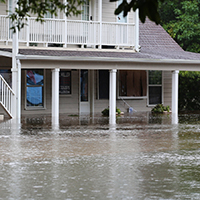
Flood Insurance & Resilience
View the page for this story
As Hurricane Irma hits the US and Texas cleans up from Hurricane Harvey’s flooding, Congress faces a September 30th deadline to reauthorize the National Flood Insurance Program. Despite some problems with this program, Larry Larson of the Association of State Floodplain Managers tells host Steve Curwood that flood insurance shifts at least some of the costs of disaster recovery to homeowners to incentivize flood-resilient rebuilding. Larson argues Congress could improve incentives for prudent rebuilding for states and local communities as well. (16:43)

Beyond the Headlines
/ Peter DykstraView the page for this story
Peter Dykstra and host Steve Curwood discuss two contradictory science-related Trump administration nominees as well as developments on the Zika Virus, this week in Beyond the Headlines. They also note the devastating Great Galveston Hurricane that hit Texas in 1900. (04:20)

Science Note: Fish e-DNA
/ Don LymanView the page for this story
New York’s rivers teem with fish, but it’s hard to keep track of the different species. As Don Lyman explains in this week’s Note on Emerging Science, researchers have found a new way to measure fish migration and what New Yorkers are eating, by DNA left behind in the water. (01:38)
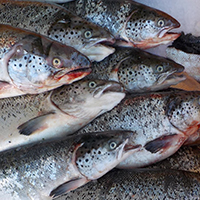
The Great Fish Escape
View the page for this story
It’s no surprise to see high numbers of Chinook and Coho Salmon in Puget Sound off Seattle, but a catastrophic failure of a large aquaculture pen near Cyprus Island freed thousands of non-native Atlantic salmon. In the aftermath of this outbreak, conservation group Wild Fish Conservancy (WFC) has launched a lawsuit against the international corporation, Cooke Aquaculture, the company responsible. WFC Executive Director, Kurt Beardslee, joins host Steve Curwood to dive into this fishy fiasco. (10:28)
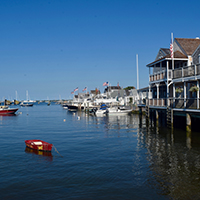
Nantucket Wharf Audio Postcard
/ Noble IngramView the page for this story
On a busy Nantucket Island wharf, Living on Earth’s Noble Ingram came across fishermen, music and historically-costumed tour guide Orion Couling. (03:18)
Show Credits and Funders
Show Transcript
HOST: Steve Curwood
GUESTS: Cyrus Reed, Larry Larson, Kurt Beardslee
REPORTERS: Don Lyman, Noble Ingram
[THEME]
CURWOOD: From Public Radio International, this is Living on Earth.
[THEME]
CURWOOD: I'm Steve Curwood.
This season’s monster hurricanes are not only costing lives and property, the related floods are also unleashing poorly regulated toxic pollution.
REED: In the wake of this extreme climate that the whole country seems to be facing, we really need basic chemical safety rules in place, so that we know what the best practices are and what to do in an emergency and what chemicals are out there. That seems basic.
CURWOOD: Harvey’s disastrous flooding has left tens of thousands of homes uninhabitable, and highlights the need to recraft the national flood insurance program so people are adequately covered.
LARSON: Now we know, after a disaster, everybody will get disaster relief. The point of the flood insurance program was to say, at least those people at risk are paying a portion of that cost through their premiums, to reduce the amount of dollars that taxpayers paid for disaster relief.
CURWOOD: That and more, this week on Living on Earth. Stick around.
[NEWSBREAK MUSIC: Boards Of Canada “Zoetrope” from “In A Beautiful Place Out In The Country” (Warp Records 2000)]
[THEME]
Hurricane Floods & Toxic Chemicals

The Texas gulf region is home to a massive concentration of oil refineries and chemical plants. (Photo: Steve Miller, Flickr CC BY-NC-SA 2.0)
CURWOOD: From PRI, and the Jennifer and Ted Stanley Studios at the University of Massachusetts Boston, this is Living on Earth. I’m Steve Curwood.
This year’s deadly hurricane season is running up a staggering tab in terms of lives lost or disrupted, homes damaged or destroyed, and major shocks to our economy, ranging from huge business and government losses down to spikes in gasoline prices. But there is another cost that is literally below the surface in many cases, and that is the toxic and infectious pollutants which the storms have released into the air as well as the water.
In the Houston-Beaumont-Port Arthur region of Texas, benzene, toluene, hydrochloric acid, and sulfur dioxide are just four of the dangerous compounds already known to have been released by the unprecedented flooding from Hurricane Harvey. The region is home to some 3,700 gas, oil, or petrochemical businesses, and over 40 superfund sites, and officials and activists are just beginning to assess the storm-related human health risks, among them the Sierra Club.
Cyrus Reed runs conservation efforts for Lone Star Sierra and he joins us now. Welcome to Living on Earth.
REED: Thank you so much. I'm glad to be here.
CURWOOD: What concerns you most about the industrial pollution so far in southeast Texas in the wake of Harvey?
REED: Well, first of all, it's just the incredible concentration of these industrial facilities in close proximity to where the hurricane hit, and more importantly in close proximity to millions of individuals. So. it's really the cumulative effects of all those refineries, all those chemical plants, all those hazardous waste sites, all those Superfund sites, all within the larger Houston-Belmont-Port Arthur, all the way down to Corpus area.
CURWOOD: So, how soon will we know exactly how much chemical pollution is out there from this storm?
REED: Well, I don't know that we'll ever know exactly. So, both the TCEQ, Texas Commission on Environmental Quality, and the EPA frankly put in some temporary rules in place which gave some flexibility to the industries in the immediacy of Hurricane Harvey. So, a lot of these reports that are required under law to be reported are really being done on a voluntary basis. But what we have seen is more than two million pounds of different chemicals being released as part of either emergencies or emergency shutdowns by some of these refineries, but we've also seen spills when there have been accidents and big concern for the community is the Superfund sites, 13 of which were flooded.
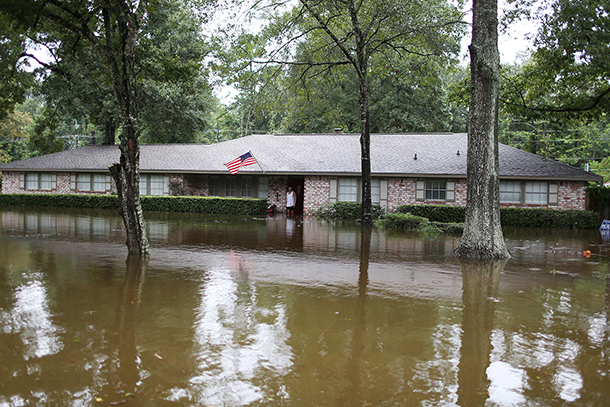
Hurricane Harvey poured many feet of floodwater – likely laced with fecal matter and toxic contaminants --into Texan neighborhoods. (Photo: Jill Carlson, Flickr CC BY 2.0)
CURWOOD: Talk to me about the San Jacinto waste pits Superfund sites. What's in there? What's the risk to public health if the water dissolves or somehow releases those chemicals?
REED: Well, it has already been a problem at the site, right? These are old chemical sites, old chemicals that have been buried there. A lot of it is dioxin. Dioxin is a highly dangerous toxic. The EPA has already come up with an initial cleanup plan, but in the meantime they had only a temporary cap on some of this area, and there is a difference of opinion about whether that cap has been breached.
We have an organizer in Houston that's been to the site and says, “It's been breached.” There is the potential that contaminants have gotten out into the environment and frankly into neighborhoods in that area. EPA is continuing to say, “We're assessing it. We don't think there's any immediate danger.”
CURWOOD: Now, the explosion at the Arkema chemical plant is the most obvious example of an industrial site malfunctioning after Harvey, and actually being able to see what's going on. I mean you get a fire and explosion and big black smoke. What was in that smoke?
REED: Well, again I'm going to plead a little bit of ignorance because under the last administration there were some rules that were passed, some new rules, chemical safety rules known as risk management plans that companies, refineries and chemical plants, were supposed to be required to have that information on site and provide it in terms of emergency. One of the first things the Trump administration did a few months ago was delay that rule until 2019. So, literally we had police and sheriff's department responding to an accident where they didn't have a full list of the type of chemicals that were on-site and could be released. You know, the main one was a peroxide, a hydrogen peroxide, but there may have been other chemicals released that we don't know about.
CURWOOD: What's your understanding of why the event at the Arkema plant happened and what risk might still remain?
REED: It really has to do with the chemicals that they were storing on site need to be refrigerated. So, when the power went out those chemicals were highly volatile and reacted. And so, although they apparently had a backup power system, it also didn't function. They knew it was going to explode. They said, “People might want to evacuate a couple miles away from this facility because this thing is going to blow at one point.”
CURWOOD: So, you have people living near these Superfund sites that have been flooded along with some of the refineries and chemical facilities. What do those folks who live nearby...What are they noticing and with experiencing firsthand?
REED: I'm not there, but according to our organizers and people we've spoken to in that area, there is much confusion in the Houston area and north of there in Beaumont and Port Arthur, whether people should return to their homes or not, whether the testing has been done to make sure it's safe or not. Honestly, a lot of people are returning to their homes, even though the testing hasn't really been done.
Another explosion just occurred at #Arkema. This video was sent to me by a neighbor who lives 2.6 miles from the plant @BuzzFeedNews pic.twitter.com/BqXQHot1EG
— Andrew Kimmel (@andrewkimmel_) September 3, 2017
So, we've had not only the Superfund site and the Arkema explosion, but there have been some spills at places like the Valero facility and the Chevron Phillips facility and the Chevron terminal where we don't know whether that threat has been remediated yet, and yet people live in those areas and are returning.
And then you couple that with the fact that - not even talking about industrial and chemical plants - we also have a lot of, about a third of the wastewater treatment plants in the area did fail and had overflows. There may be a lot of high levels of fecal coliform, you know, poop that got out there and is still either in puddles or in the soil that people need to be careful about.
CURWOOD: As we're speaking, we're closely watching Hurricane Irma, and it seems that Harvey was a long time ago, but it wasn't so long ago we were looking at pictures of people wading through waist deep, even neck deep water. You're telling me that this water likely had, well, some poop along with some toxic chemicals along with, I mean, what were people exposed to? What's the health risk here?
REED: Well, according to the TCEQ, of the 1,200 wastewater treatment plants in that general area, 800 of them were working, which means about 400 weren't working, and we have almost 100 reports of wastewater overflows at some of those plants. Now, if people who waded through that then cleaned off, didn't put the same clothes back on, they probably should be OK, but there's going to be...You know, a lot of people obviously are cleaning out their house replacing the dry wall because a lot of it is likely very contaminated.
CURWOOD: How can Texas move forward now with a just recovery that doesn’t burden poor people and low income people of color in these areas, who already obviously are struggling in the wake of the storm, not having a whole lot of capital resources to begin with anyway?
REED: Well, I think one is, as I mentioned before, we really need to increase funding for the basic testing to make sure these areas are safe to go back to. So, that would be one step, and, in particular, that would be Superfund where we have a large amount of chemicals on site. But we also need to look at our rules and regulations. So, the Trump administration decided to delay these chemical safety rules. In the wake of this extreme climate that the whole country seems to be facing, we really need basic chemical safety rules in place, so that we know what the best practices are and what to do in an emergency and what chemicals are out there. That seems basic.
The other is, we have what's called the Railroad Commission of Texas, which does not regulate railroads. It regulates oil and gas; it's a historical name. But they're one of our most important state agencies, and yet their rules are very outdated. An example of this is they don't require sub-surface shutoff valves for oil and gas wells and for disposal wells in flood zones and in hurricane zones, and it seems like a basic thing is, we should have shut off valves so when there is a storm we can shut off those wells and make sure they don't leak.
We have waste sites here in Texas that take drill cutting and fluids from oil and gas production, and yet we only design them for a 24-hour rain event, which means any time you have more than 24 hours of rain, those things are going to flood and affect neighborhood and land, and that seems like something we have to change. And we have outdated spill response rules, what to do in a time of flood, how do oil and gas producers report? How do they clean it up? So, we've got a lot of regulatory work to do here as well as the EPA, but just here in Texas as well as increased funding, but there may be some neighborhoods where we need to relocate people. That's going to be expensive, but in some cases we're going to have to do it.
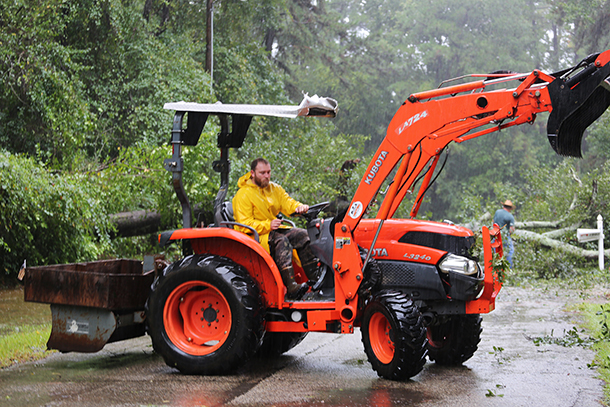
The rebuilding process from Hurricane Harvey is already underway. (Photo: Jill Carlson, Flickr CC BY 2.0)
CURWOOD: With climate change, with global warming, we're seeing this change in the hydrologic cycle, the rain cycle, kind of like it swallowed steroids, and right now, as we're talking, we looking at the aftermath of Harvey, Irma is doing its thing. We're also seeing crazy fires out in California due to dryness. From your perspective, what needs to be done to protect the public in the aftermath of these things because all these events create, well, not exactly the healthiest conditions?
REED: You know, it's kind of like the 12-step program. First you've got to admit you've got a problem, and we need both political parties, not just one, to admit that climate change is real and, therefore, we need to be prepared for it. We need to try to mitigate it as best we can but also be resilient about it and design our cities and our institutions in a way to withstand these extreme events. The city of Houston should do that as well as they rebuild.
You know, a lot of cities out there that are more forward thinking have looked at green infrastructure. What's the way that you can use parks and green space to absorb floods or hurricanes? The hydrological cycle, yes, is changing but we also have more people and more concrete, which makes for flashier floods.
CURWOOD: Cyrus Reed is the Conservation Director of the Lone Star chapter of the Sierra Club. Thanks so much for taking the time today.
REED: I appreciate it. Thank you.
Related links:
- Sierra Club interactive map of toxic sites affected by Hurricane Harvey
- Cyrus Reed staff profile
- San Jacinto Superfund Site
- NYTimes: “Crisis Is Over at Texas Plant, but Chemical Safety Flaws Remain”
[MUSIC: Gil Shaham/Adele Anthony/Akira Eguchi, “Song of the Nightingale, Op.29,” on Sarasate: Virtuoso Works for Violin, composed by Pablo de Sarasate, Canary Classics]
CURWOOD: Coming up...as monster storms batter the US, the federal flood insurance is in trouble. That’s just ahead on Living on Earth.
ANNOUNCER: Support for Living on Earth comes from the Gordon and Betty Moore Foundation, and from a friend of Sailors for the Sea, working with boaters to restore ocean health.
[CUTAWAY MUSIC: Gil Shaham/Adele Anthony/Akira Eguchi, “Song of the Nightingale, Op.29,” on Sarasate: Virtuoso Works for Violin, composed by Pablo de Sarasate, Canary Classics]
Flood Insurance & Resilience
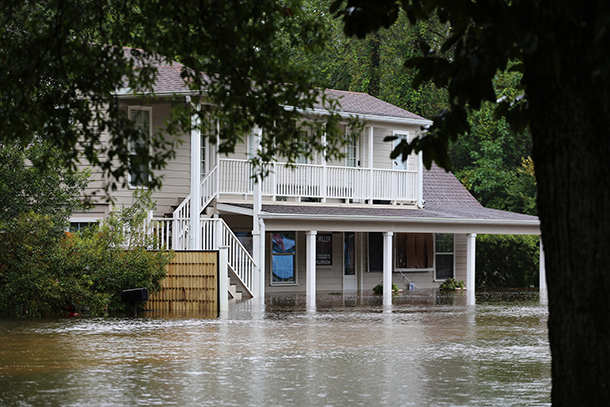
The floodwaters left by the 2017 hurricanes inundated many homes, most of which lack flood insurance. (Photo: Jill Carlson, Flickr CC BY 2.0)
CURWOOD: It’s Living on Earth, I’m Steve Curwood.
Few people actually buy federal flood insurance. While premiums have been rising, they don’t cover claims, and the program runs out of cash on September 30th, unless Congress acts. Flood insurance needs a “rethink” to put it on a sound financial footing, and the US needs new policies to help mitigate future disasters.
Well, in a recent Washington Post op-ed, two flood risk experts, Larry Larson and David Conrad of the Association of State Floodplain Managers, describe how the Great Flood of 1993 in the upper Midwest briefly focused federal attention on the importance of mitigating flood risks. But that sense of urgency quickly waned, and at-risk communities, including Houston, Texas, largely ignored the need to mitigate flood risks.
And here now to discuss the issue is Larry Larson. He's Policy Director and Director Emeritus of the Association of State Floodplain Managers. Larry, welcome to Living on Earth.
LARSON: Thank you very much, Steve. It's good to be with you.
CURWOOD: Now, so, Larry, you clearly hoped the nation would learn its lesson after the 1993 floods. How close did we come to getting flood policy right at that point, in your view?
LARSON: Well, I think in terms of national policy we did something after 1993 that we had not been doing prior to that. Prior to that both in disaster relief and our flood programs, we were telling people we will help you rebuild after disaster, but we will only make you whole, we'll only build you the way you were, we will not help you mitigate.
We started to do mitigation after 1993. About 10,000 structures were bought and they were moved out of the flood plain in the one 1993 flood. That was the first time we did that. So, now after a flood, the disaster program will not only help you rebuild, there's a portion of the disaster program called the hazard mitigation match program that communities can put together an application and send it to FEMA and the state saying, “Here's a neighborhood of 50 homes that were flooded. The ones that are really low, here's an application. We'd like to relocate those people out. The other ones, we’d like to elevate three feet so they're above the flood level, and people can afford insurance.” And it's cost effective. It returns $4 for every dollar we spend. In the case of flood, it's $5 for every dollar.
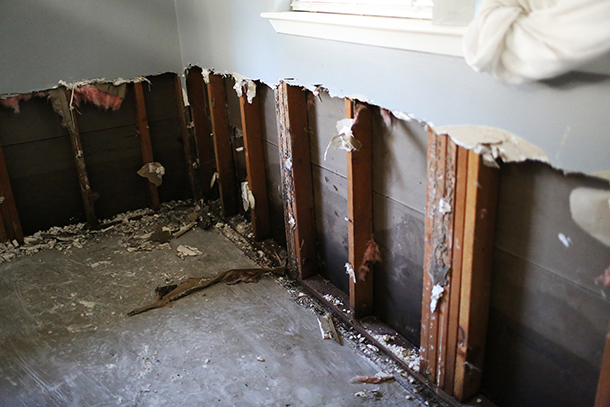
Dealing with flood damage is expensive: every foot of water in a home costs about $20,000 worth of damage, and many homes in 2017 have been flooded with several feet of water. (Photo: Jill Carlson, Flickr CC BY 2.0)
And we do the same in the Flood Insurance Program. Policyholders actually fund a mitigation program called the flood mitigation assistance program at $175 million a year. FEMA uses that money and tries to focus that money on buying out those severe, repetitive loss structures. So the ones that are really draining the program. You've heard those stories. About 25 to 30 percent of the claims are from those two percent of the policyholders. So, that's one that they try to focus on.
CURWOOD: So, what is the present tab now that the federal government is picking up, in terms of disaster relief?
LARSON: Well, about 30 years ago the federal government paid about 24 cents on the dollar for disaster relief. Now it's about 76 cents. So, what we're seeing is that the federal taxpayer’s picking more of these costs. Well, if you look at where floods are happening, the big floods are happening in states that may do the least, in terms of preventing flood damage. And then, of course, Congress says, “Well, this was a major disaster because nothing was resilient, so now instead of giving you 75-25”, which is a standard cost share for disaster relief, 75 Fed, 25 percent un-Fed, we'll give you 100 percent.” So, we're kind of encouraging bad behavior with some of those policies. We've got to quit incentivizing poor behavior and instead let's incentivize good behavior.
CURWOOD: What about allowing people to build in these areas that have been known to flood and get insurance now? Why can people do this now?
LARSON: Well, we still sell car insurance to those people who have accidents. Now, they may pay more for their car insurance, but the same is true in flood. Now, we know after a disaster everybody will get disaster relief. The point of the flood insurance program was to say, at least those people at risk are paying a portion of that cost through their premiums. So, it makes sense for those in the floodplain to actually buy the insurance. We don't want to say, “Don't buy the insurance,” because then we're only going to have disaster relief, taxpayer dollars, to help after a flood. So, we need to better marry the flood protection standards in the NFIP with the disaster program to say, “Wait a minute, if you do a better job of making sure new development is at less risk of flooding, you'll be getting a better portion of disaster relief.” So, we've got to build in some kind of incentives. We were supposed to do that in the last administration. That is still being considered by this one, called “The Disaster Deductible”, saying to the states, “Every state will have a deductible which you must pay before we come in with the federal taxpayer dollars after a disaster, but the more you're doing to reduce floods on new development and redevelopment, the more credit we'll give you so that your deductible goes way down, and you already may be doing enough that you have no deductible.”
CURWOOD: By the way, why is it important for the nation to really get its flood risk mapping up-to-date, and how comprehensive is the mapping of flood zones today?
LARSON: Maps are the basis for what communities do in guiding development. They need that map.
There are in the United States about 3.5 million miles of coastlines and rivers that have flood plains. The NFIP has mapped about 1.2 million of those miles, so that's about a third, so that means we have two-thirds of the flood plains in the United States that have not yet even been mapped. Now, a lot of those are out in smaller communities, in rural areas because FEMA has focused on doing highly urbanized areas where they have the highest policy count, but they want to have as good a map as they can to get their premium rates determined. But the problem is, now that we keep redoing those maps instead of going out into the, what I call, “cornfields and cow pastures.” those other areas we need to map now and get ahead of development because that's where developments are going in, outside those areas and the suburban areas.
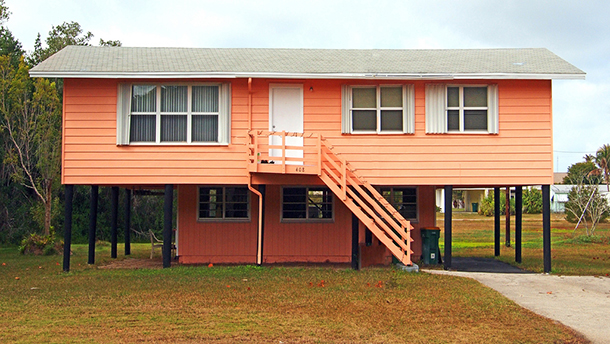
Raising homes above the level of predicted 100-year flood can greatly reduce damage and costs from floods. (Photo: JohnPickenPhoto, Flickr CC BY 2.0)
A developer comes out and says, “I'm going to put 200 homes out here...do I need a floodplain permit?” And the community says, “I guess not, we don't have a flood map showing we have a floodplain out there, so go ahead and develop.”
They do that, and then later FEMA comes along and says, “Well, we need to map that because there's a development out there now.”
They'll map it, and now all the people that have built probably built two or three feet too low, and now they're going to have to buy flood insurance, and the premiums are going to be up because they didn't build high enough. That's where the screaming starts and the people start shouting and saying, “Wait a minute!”
And that could have been avoided if we would map ahead of development. It cost only one or two percent higher to elevate a structure two feet on the development costs, so if we can get ahead of development we can start to prevent some of these problems.
CURWOOD: A number of folks said that, in Houston, development was permitted in areas that made no sense in terms of flood plain, but how much did all that development affect the flooding in Houston?
LARSON: A tremendous amount. You can't pave over thousands of acres of what was wetland or a lot of it was pasture area and so on and not have an impact on runoff because you took all that pervious surface that would soak up water and turned it into an impervious service where the water simply runs off.
CURWOOD: How well can you guess what happened in Houston in terms of an increased flood level due to this, all this impervious surface that was there? How many feet do you think it might have cost people in areas of Houston to have paved over so much?
LARSON: I can't really say. I mean, you can do a study on that. Charlotte, Mecklenburg found out that if their small watersheds were fully developed, the flood levels would go up anywhere from two to nine feet. They mapped future conditions, so that when people built, it would be safe when full development occurred. So, that shows you what kind of impact development has on a watershed.

Much recent construction in the Houston area was built on what used to be marshland and grassland, replacing these water-absorbing ecosystems with mostly impervious surfaces. (Photo: Nelson Minar, Flickr CC BY-SA 2.0)
We're doing a little better job of doing our studies on a watershed basis, but, as you know, community boundaries don't match watersheds. So, given this, community A can work with community B to consider the runoff and the impact of that development it's going to have. That's one of the reasons we develop what we call “a no-adverse impact approach” and try to help communities look at this to say, “Don't just look at what's happening in your floodplain. Look at what's happening in your watershed, and if all that stuff is increasing your flood flows you’d better account for that.” That's a no-adverse impact approach.
CURWOOD: What's under consideration now in the Congress, in terms of reforming the flood insurance policy, and, I gather, making an appropriate link to disaster relief with it?
LARSON: Well, the House bill has a heavy focus on allowing the private sector to sell flood insurance directly which is kind of surprising because they opened it up in 2012, in the reform of 2012, and frankly the private market is coming aggressively into the program now. It's selling private flood insurance throughout the nation now. They have a small amount. The numbers I've read are around 200,000 policies compared to the NFIP at 5 million
And our biggest concern with private flood is the way the bill was written. The private flood policies would not be required to pay a $50 a year policy fee that all in NFIP policy holders pay. That money pays for about half of the costs of new mapping, and it pays for all the floodplain management, providing assistance to those 22,000 communities that belong to the program because they need to know what their role is. They need to be monitored. They need to understand their maps, know how to do the job. So, we're very concerned about that.
In the Senate what you're seeing is more efforts to address the mapping, and say “Let's get the mapping done,” authorizing more money for mapping. That's not appropriations, you understand, that's authorization. But they also have a lot of stuff on mitigation and that has to happen. There's a small piece of the flood insurance policy that's very important to mitigation. It's a rider on every policy that says, “You have a rider that provides money for increased costs of compliance. “
Let me explain. It's kind of like how your homeowners insurance might have an law and ordinance provision that says, “If your community because you were damaged so heavily” and typically that number is 50 percent of the value, “then when you rebuild you must rebuild to today's code.” In the case of flooding, for example, in Sandy, that means, well, today's code may mean you can rebuild at that spot, but you’ve got to elevate your home five feet. Well, that increased cost compliance provision would provide you up to $30,000 to help you elevate. We like that.
The problem is that it we found out between Katrina and Sandy that it costs somewhere between $50,000 and $120,000 to elevate a building. So, for the person that had $50,000 in the bank, that's $30,000 really helps. For the person that's living paycheck to paycheck it says, “Well, it's going to cost you $80,000, and here's $30,000 by the way.” That's just another $50,000 loan they've got to add on top of the loan they're already struggling to meet. So, the Senate diversions are saying, “Let's increase that to $60,000 or to $100,000 so that people can actually mitigate after the flood.” Again, going back to the fact that if we help them mitigate we're getting a four-to-one payback for the taxpayers, so, let's get that done. So, that's a very important piece and if that provision can be increased, and the Senate bills do that, they increase that significantly, we think that that's a move in the right direction.
CURWOOD: Larry, let's step back for a moment. I want you to give me the big picture for the small person. So, if I have a dwelling unit there in Houston, and I had bought flood insurance, what kind of financial ride am I in for now for this, say, $175,000 home that I have?
LARSON: Well, let's assume that, of course, you're only required by the law to buy enough insurance to cover the mortgage. So, on that $175,000 home you just talked about, if I had a mortgage for $100,000, that's all I had to buy. If I had a mortgage for $20,000, I only want to buy $20,000 dollars worth of flood insurance, and unfortunately the propensity of the average person is to buy the minimum amount. So, if I had a $20,000 mortage, I bought $20,000 worth of flood insurance, and that's all the bank cares because they know they're going to get their money.
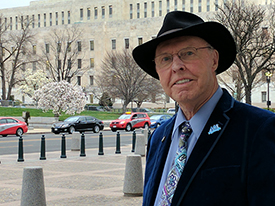
Larry Larson is a policy advisor and director emeritus of the Association of State Floodplain Managers. (Photo: Association of State Floodplain Managers)
This program, in fact, the courts in some court cases, the courts have said, “Well this program was really designed to protect the banks, not the policy holders.” So, let's say that person had just had $20,000 and now I have four feet of water in my house. Well, one feet of water typically costs $20,000. Two feet of water costs $40,000. If you had four or five feet of water, you're probably looking at at least 50 percent of the value of that structure. You probably had $80,000 of damage, and, if you were fortunate that your mortgage was high enough so that you actually had $100,000 worth of coverage, then you'll get a pretty good return and if you didn't have flood insurance, now you're going to be at the whim of disaster relief.
And the disaster program has two major elements. One is called public assistance, which builds roads and highways and sewer plants and water plants and all those public facilities. And the individual assistance which will provide some minimal assistance to individuals. It's usually temporary housing. That's authorized to pay up to $32,000 for a family. The average is about $7,000.
CURWOOD: Sounds to me that a lot of folks who got flooded out in this spate of storms are literally underwater financially and may be tempted simply to walk away from these homes.
LARSON: Well, we saw some of that happen, and we've seen that happen in the past, and I think you're going to see more of that happen in the future because, as we see these high damage amounts and people not having insurance, it's a problem. Until we get to the point where insurance is ubiquitous, and it's probably going to have to be mandatory, our experience is that the only people that buy flood insurance are where it is mandatory to buy it. It's difficult for people to judge risk because people, first of all, don't think their area is going to flood. and if it does flood, they surely don't think it's going to happen to them. That's just the mindset of people, period. And that's, that's a mindset that's very difficult to overcome, and that's one of the problems we face in trying to run our program.
CURWOOD: Larry, we're seeing rising sea levels with, with climate disruption. How does that affect the whole flood insurance program?
LARSON: What we're going to see along the coast, as sea level rises, is the insurance companies and the bond rating companies are going to look at the value of that real estate, and frankly when sea levels go up a foot or two, a lot of that real estate is going to lose value. That's very high priced real estate, and suddenly those $300,000, $400,000 homes are going to go down $100,000 in value. Well, that affects the community's bond rating because that reduces their taxes, doesn't it?
So, as we see a sea level rise, we're going to see this resilient factor playing well into the financial stability of the community. These are going to be tough issues that communities are going to have to address, and some are. The Miamis and some of the Florida communities, and New York City is taking a very careful look at this and saying, “We've got to prepare for the sea level rise. It is happening. It is happening now. We've got to make sure that we're resilient as community and that we stay financially strong.”
CURWOOD: As we face all of these storm disasters this year -- Harvey, Irma, and who knows what else -- how much comfort should we feel with the existing flood insurance program? If you were to give it a grade, is it an A, a B, a C, a D? An F?
LARSON: I would say it's about a C. I think it's a program that's very important, and frankly 50 years from now I would hope that flood insurance is actually sold by the private sector. It’s part of your homeowner's policy. Think about it. That makes good sense. You would buy one policy for your home and it covers everything, including all floods, earthquakes, fires, what have you. But we need to transition to that in a smart way so that we don't lose the other key elements of that comprehensive flood risk management program - mapping, mitigation, regulation. That's kind of what needs to happen if we want to get there.
CURWOOD: Larry Larson is a Policy Advisor and Director Emeritus of the Association of State Floodplain Managers. Larry, thanks so much for taking the time today.
LARSON: Thank you very much.
Related links:
- Washington Post: “We already knew how to reduce damage from floods. We just didn’t do it.”
- “Setting People Straight on Six NFIP Myths” by Larry Larson
- FEMA: About the National Flood Insurance Program
[MUSIC: Einstein’s Little Homunculus, “Swallowtail/Coleraine/Bonaparte Crossing the Rockies,” on Don’t Ask, Traditional/arr. ELH, Accordion School Music]
Beyond the Headlines

A lab technician works in the Immunology department at one of Sanofi Pasteur’s locations. The company was developing a Zika vaccine in partnership with the US Food and Drug administration, which has now cut funding of the project. (Photo: Sanofi Pasteur, Flickr CC BY-NC-ND 2.0)
CURWOOD: Let’s check on the world beyond the headlines now with Peter Dykstra of DailyClimate.org and Environmental Health News, EHN.org. Peter is on the line from Atlanta, Georgia. Hey there, how are you doing?
DYKSTRA: Doing all right, Steve. Hi.
Let’s start with mixed messages from the Trump Administration on how it’s planning to address pressing environmental concerns.
CURWOOD: Well, a lot of environmental advocates would tell you that a mixed message is the best messaging they’ve heard in a while from this administration.
DYKSTRA: Yeah, that’s probably true, but President Trump took two different directions on two key appointments dealing with climate change and climate policy. Jim Bridenstine is an avid pilot and he’s the congressman for Tulsa, Oklahoma. He’s Trump’s belated pick to run NASA, one of several key home agencies for US Government climate science.
CURWOOD: Hmm, I seem to remember a previous member of the Oklahoma delegation from Tulsa who was also an avid pilot and who had a pretty strong profile on climate change.
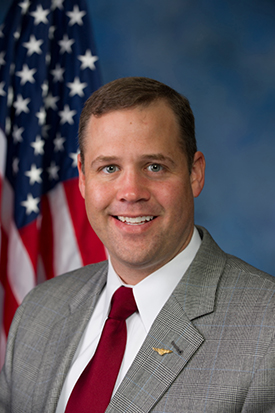
President Trump nominated Oklahoma Republican congressman and climate change skeptic Jim Bridenstine this week to head NASA. (Photo: United States Congress, Wikimedia Commons, public domain)
DYKSTRA: And he still does, and of course you’re referring to the Senate’s uber-climate denier, Jim Inhofe, who’s called climate change “a hoax”. Bridenstine’s something of a protégé of Senator Inhofe.
CURWOOD: Well, presumably not good news for the state of Federal climate science.
DYKSTRA: No it’s not, but over at NOAA, the number two slot is going to an actual scientist with an actual background in oceanography and an actual track record of concern about what the science says climate change is doing right now.
CURWOOD: Well, how did that happen?
DYKSTRA: Another mystery, but retired Rear Admiral Tim Gallaudet will be poised to swim against the tide of climate denial espoused by the President, espoused by several cabinet members, and by quite a few Senators like Jim Inhofe who will be called upon to approve his appointment.
CURWOOD: So, another policy head-scratcher. What’s next?
DYKSTRA: Well, one of the fierce new stresses of 2016, thought to be here to stay, has pretty much been AWOL for the year 2017. Do you remember Zika?
CURWOOD: Oh, yeah, the widespread mosquito-borne disease that caused so many birth defects a year ago.
DYKSTRA: Well, in 2017, I’m happy to report that it’s pretty much stopped. Cases in South America and the Caribbean are way down, and the Florida Department of Health has received one-tenth the number of new case reports than they did a year ago.
CURWOOD: Well that’s good news, but is there a reason for this decline?
DYKSTRA: We don’t know what the reason is, but let’s take the good news where we can get it, whether it’s in Florida and Latin America, even if there’s good news with a bad news component.
CURWOOD: Uh-oh, I thought there’d be a catch. What’s the bad news?
DYKSTRA: The vaccine-making giant Sanofi Pasteur has been working on a Zika vaccine, but its partners at the US Food and Drug Administration lost interest and dramatically cut funding, so no more vaccine project. It would have been nice to have a vaccine, if Zika should make a comeback.
CURWOOD: Agreed. Hey, Peter, finally, let's crack open the history books for this week.
DYKSTRA: Sure, and let’s set the way-back machine for the year 1900. The Great Galveston Hurricane of September 8, 1900 could make a pretty good claim to being the storm of the century. Galveston, just 50 miles southeast of Houston, had already blossomed into a major vacation spot on the Gulf of Mexico, and it was also a major shipping town to export cotton and the other goods of the great state of Texas. In 1900 the US Weather Bureau was only thirty years old, and forecasting models didn't have computers, or satellites, or even wireless warnings from ships at sea.
CURWOOD: So, we had no warning that a huge storm was bearing down on Galveston?
DYKSTRA: Well, that’s the thing. Actually we did, but political rivalries got in the way. The storm had already done a huge amount of damage in Cuba. Then it gathered strength across the warm waters of the Gulf of Mexico, and Cuban meteorologists tried to warn their American counterparts, but the American weathermen and the Cubans hated each other’s’ guts, so the Cuban warnings went largely ignored.
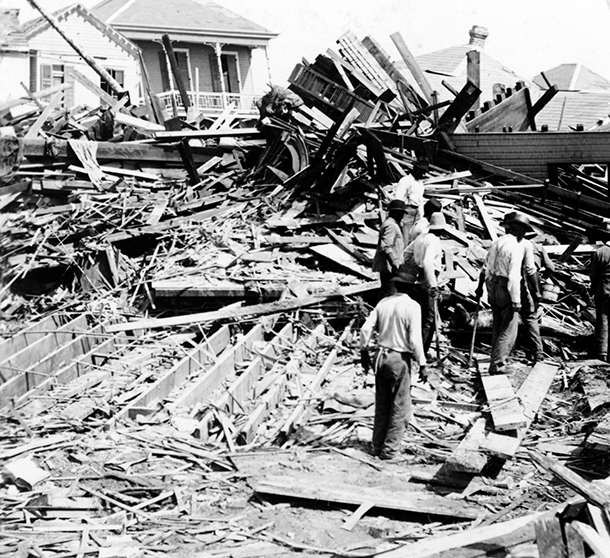
CSurvivors search through the wreckage of the Great Galveston Hurricane of 1900 (Photo: M.H Zahner, U.S. Library of Congress’ Prints and Photographs Division, Wikimedia Commons public domain)
CURWOOD: And more than, what, 6,000 people perished?
DYKSTRA: At least 6,000. But you know, today, with modern forecasting and instant communications and the painful lessons of Galveston and other disasters, the death tolls for comparably fierce storms in a bad hurricane year, like the one we’re in now, is way down from the Storm of the Century of the year 1900.
CURWOOD: Peter Dykstra is with Environmental Health News – that’s EHN.org – and DailyClimate.org. Thanks, Peter, we’ll talk to you again real soon!
DYKSTRA: All right, Steve, thanks a lot. Talk to you soon.
CURWOOD: And there’s more on these stories at our website, LOE.org.
Related links:
- USA Today: “Trump nominates Oklahoma congressman as next NASA administrator”
- Science Magazine: “Breaking: Trump picks NASA chief, NOAA second-in-command”
- NPR: “Is Zika Still A Problem In Florida And The Caribbean?”
- Florida Health Department: about the Zika Virus
- Read further about the 1990 Galveston hurricane: “Isaac’s Storm: A Man, a Time, and the Deadliest Hurricane in History”
[MUSIC: Einstein’s Little Homunculus, “Disobedience,” on Don’t Ask, Traditional (Morrison’s Jig) /arr. ELH, Accordion School Music]
CURWOOD: Coming up...down at the docks on Nantucket. That’s just ahead here on Living on Earth. Stay tuned.
ANNOUNCER: Funding for Living on Earth comes from you our listeners, and United Technologies - combining passion for science with engineering to create solutions designed for sustainability in the aerospace, food refrigeration and building industries. UTC companies such as Otis, Carrier, Pratt & Whitney and UTC Aerospace Systems are helping to move the world forward.
This is PRI, Public Radio International.
[CUTAWAY MUSIC: Billy Ward with John Petitucci, “Devaney’s Goat/The Whistling Postman” on Two Hands Clapping, Traditional, Drum Pike Records]
Science Note: Fish e-DNA

By testing environmental DNA, or eDNA, in New York’s East River and Hudson River, scientists tracked migration patterns of fish such as these striped bass (Photo: Chesapeake Bay Program, Flickr CC BY-NC 2.0)
CURWOOD: It’s Living on Earth, I’m Steve Curwood.
In a minute, salmon on the run, but first this note on emerging science from Don Lyman.
[SCIENCE NOTE THEME]
LYMAN: For the first time, scientists have used DNA collected just from water samples to conduct a fish migration study. For six months, researchers from Rockefeller University took one liter water samples each week from the East River and Hudson River in New York. As fish swim they leave traces of their DNA in the water, from the slimy outer coating on their bodies or in their waste. By using this environmental DNA, called eDNA, the scientists were able to determine which fish species swam through the water on each test day. The eDNA data correlated with previous fish migration studies using trawls with fish nets that had taken many years to conduct. This new technique requires a fraction of the work and cost of trawling and doesn’t harm any fish.
As for the results, the researchers identified the DNA of 42 fish species, including most of those known to inhabit the rivers, such as menhaden, striped bass and toadfish. E-DNA also provided the researchers with a mystery, as they found DNA of fish species such as tilapia, salmon and red snapper, species that don’t swim in the Hudson River. But they are species commonly eaten by New Yorkers, leading the scientists to conclude that the DNA probably passed through humans and the wastewater treatment system. The researchers note that this could provide yet another use for eDNA, helping to identify endangered species being sold as food in local stores and restaurants.
That’s this week’s note on emerging science. I’m Don Lyman.
Related links:
- Rockefeller University: “Researchers track fish migration by testing DNA in seawater”
- Yale Environment 360: “A Splash of River Water Now Reveals the DNA of All Its Creatures”
[SCIENCE NOTE THEME]
The Great Fish Escape
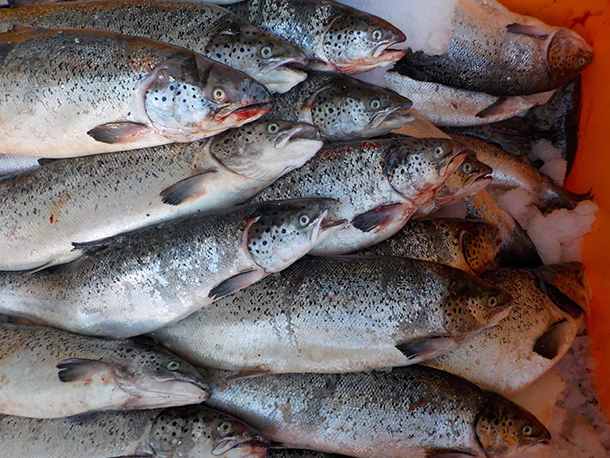
More than 160,000 Atlantic Salmon escaped from a broken aquaculture pen off the coast of Cyprus Island in the Puget Sound. These escapees were caught by local fishermen and await identification. (Photo: The Wild Fish Conservancy)
CURWOOD: Puget Sound, the large Pacific estuary system in Washington State, offers the perfect refuge for spawning Coho, Chinook and Sockeye salmon, but in late August local fishermen were bewildered when they caught Atlantic salmon as well. Days later, the news broke that 160,000 Atlantic salmon or more had escaped from damaged aquaculture nets moored off the San Juan Islands.
In the wake of this great fish escape, the Wild Fish Conservancy has filed a lawsuit against the company that owned the fish farm, Cooke Aquaculture, for damages to the watershed.
Kurt Beardslee, the Executive Director of Wild Fish Conservancy joins us now to explore the impact of this fishy jail break. Welcome to Living on Earth, Kurt.
BEARDSLEE: Thank you, Steve.
CURWOOD: So, Kurt, how did you find out about this salmon escape?
BEARDSLEE: Actually, it wasn't a public announcement. It was an individual that left a message at our office that had heard a conversation between the Coast Guard and the net pen industry that there had been a problem, and so it was just the public, basically, let us know, and that was three days after the event had occurred, and there had been no previous public notice.
CURWOOD: And to what extent were you able to actually see the damaged farm salmon pens and the damage, yourself?

Many of the escaped salmon were bloated with fat, like the specimen above. As Kurt Beardslee noted, farm-raised fish are pumped with food and bred to grow fat faster and at higher concentrations than their wild counterparts. (Photo: The Wild Fish Conservancy)
BEARDSLEE: I had actually previously had been up there. I just basically turned around and went right back. I took a boat out to the site and I was expecting to see a net that had basically come loose from the physical structure of the pen, the rigid structure, but instead I saw a twisted mass of steel pipe and cable and chain. I have been doing work on Atlantic salmon net pen issues for many years, and I've never seen anything quite as episodic as this.
CURWOOD: What happened? Do you have any idea what took things wrong there?
BEARDSLEE: It appears that the net pen itself was structurally failing, and just an average tide finally made it collapse.
CURWOOD: From your understanding, how aware was Cooke Agriculture they had a problem with there in fairly imminent risk of collapse?
BEARDSLEE: They were very aware that their structure was structurally compromised. It was old. It needed replacing. Their reports back to the agencies stated exactly that, and they were hoping to harvest one more year out of these pens before they replaced them, but their gamble didn't work out. The sad part is, is that our agencies that are supposed to oversee this allowed them to fully fill these pens with 305,000 non-native fish. They allowed them to risk the health of Puget Sound, so this industry could get one more year's worth of growth. That is not very good oversight, from my perspective.
CURWOOD: I got to confess. I'm a bit confused. Why would anyone farm Atlantic salmon in Puget Sound, the home of, well, there’s wonderful Pacific salmon there? Why would they do that in the first place?
BEARDSLEE: Well, Atlantic salmon are more easily domesticated. They deal with these close containments much better than Pacific salmon, so the industry has chosen pretty much around the world to use Atlantics in that industry.
CURWOOD: What kind of impact was this type of open water aquaculture having on the region, even before all these Atlantic salmon escaped.
BEARDSLEE: That's a great question. And it's one that I was hoping more people would learn about during this event because this was a catastrophic event that obviously caught a lot of people's attention, but what doesn't seem to get their attention is what happens every single day in Puget Sound. This industry is, is highly subsidized, and I say that because they dump all of their waste directly into Puget Sound. On some occasions, aside from fecal material they'll also have pharmaceuticals or viruses or parasites that they put directly into Puget Sound that are harmful for the health of Puget Sound and for all organisms that live in Puget Sound.
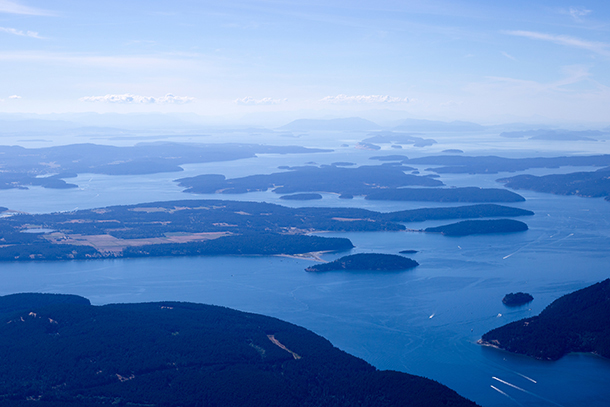
The San Juan Islands form an archipelago at the northern end of the Puget Sound. Though these waters are public, they house all of Cooke Aquaculture’s net pen operations in the state of Washington. (Photo: Eric Prado, Flickr CC BY-NC 2.0)
CURWOOD: So, now that these Atlantic salmon are out in Puget Sound, some 160,000 of them, more or less I guess, what are the risks to the indigenous species? I'm thinking especially of the Chinook. What risks do these fish pose?
BEARDSLEE: Well, there’s a host of risks. First, they are going to compete for food and for habitat. They are going to compete on the spawning ground. Even though they can't successfully reproduce with Pacific salmon, they can compete for mates and have unsuccessful spawnings, and that can be a problem on its own. They can introduce viruses and parasites that they may have contracted in the pen themselves. We know very little about the health of these fish because the industry is really quite opaque.
CURWOOD: Now, I imagine you've seen some of these escaped, farmed Atlantic salmon. What they look like?
BEARDSLEE: We saw a number of fish that physically on the outside had some problems. We saw some that had very deformed jaws. They could have been deformed because there they had been treated for something called Yellow Mouth which basically dissolves their jaws. It's a very ugly thing to have. These fish could not close their mouths, their twisted jaws. They all have very worn fins. They're quite bloated, many of them, because their fat levels are extremely high. They're basically force fed to grow really quickly, 18 months at the max, instead of a couple, two or three years. We took organ tissue samples to analyze for the potential of viruses that that they may have been carrying, but the organs, many of them were almost unrecognizable.
I've been doing this for 28 years and I've seen thousands and thousands of fish, and I, actually, and my technical staff are baffled at what we're seeing. These are not signs of healthy fish. Something's wrong.
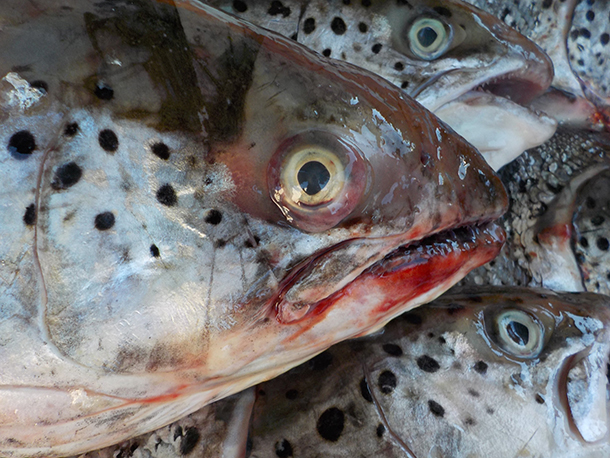
Most of the Atlantic salmon caught by the Wild Fish Conservancy had little or no pigment on the crown of the head and around the eye. (Photo: The Wild Fish Conservancy)
CURWOOD: So, how are the fishermen, particularly the native Lummi fishermen, responding to this spill? What benefits, if any, are they seeing from bigger catches? I mean, there are a lot more fish right now.
BEARDSLEE: We've spent a lot of time with the Lemmi tribe, and I have not seen a single tribal member that's happy about what's happening. I've seen nothing but individuals that are very upset. They're out there to catch their Pacific fish that they have evolved with for the last few thousand years, and they had to take time away from their normal fishery, which they depend on, to go and catch these fish for the industry, because the industry's entire emergency response plan was to tell the public to go fishing.
I've been working over the entire holiday here, contacting the Emergency Response Command Center that was set up in Anacortes, to try to get funding for some of these fishermen that have caught these fish. They have them in cold storage. They don't want to sell them to the public. They want the industry to pay them back, and the representative I finally got ahold of from Department of Fish and Wildlife said, “The industry has no responsibility to pay the public back for cleaning up their mess.”
I'm sorry, but it was our government that permitted this industry. Our government works for us. They need to end up getting money from this industry to pay back these individuals that are now out great amounts of time and energy and money.
It's just one more aspect of how this industry is just totally subsidized by the public. They get to use public waters for free. They get to have their cleanup for free, and it's just not right.
CURWOOD: Now Kurt, you direct the Wild Fish Conservancy, and I understand that you have issued a notice of intent to sue Cooke Aquaculture. In other words, you're filing a lawsuit, you have filed effectively a lawsuit. What do you hope will come out of this litigation?
BEARDSLEE: We are hoping to hold them accountable for this toxic spill of these exotic fish. This was a negligent act. This was not an act of nature, as they tried to portray it to be, and when it is negligence the release of these fish is actually considered a pollutant, and we are going to hold them accountable for polluting Puget Sound and all of the biological ramifications and economical ramifications that come with such a large pollution.
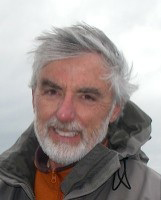
Kurt Beardslee is Executive Director and Co-Founder of the Wild Fish Conservancy, based in Duvall, Washington. (Photo: The Wild Fish Conservancy)
CURWOOD: Kurt, before you go, how many of these fish you've been caught so far, and what recovery were still remains do you think?
BEARDSLEE: Well, a lot of fish had been caught. As I was saying, gosh, a week ago, we had 50,000 pounds of them at home port in Bellingham. I just was talking to commercial fishermen yesterday, and they say they're still catching these fish, so we're planning on gathering more of those fish and sampling those as well, but there's still a lot to be done. This is not over at all.
CURWOOD: Kurt Beardsley is Executive Director and Co-founder of the Wild Fish Conservancy based in Duvall, Washington. Kurt, thanks so much for taking the time today.
BEARDSLEE: Thank you very much, Steve.
CURWOOD: We contacted Cooke Aquaculture for a statement. Their Communications Manager, Chuck Brown, sent an email that reads in part,
“We will review the Wild Fish Conservancy’s claim and we will respond through proper channels. Our focus has been on properly and safely removing the fish and equipment from the farm and working with tribal partners, experts, and agencies to meet our obligations.”
Related links:
- Washington State legislation protects aquaculture
- Cooke Aquaculture September 6 statement on its failed salmon farm
- Washington State DNR notice on the Cypress Island Atlantic Salmon Pen Break
- Wildlife Fish Conservancy
- Cooke Aquaculture
- Washington State Department of Fish and Wildlife
- Initial Seattle Times coverage: “Please go fishing, Washington state says after farmed Atlantic salmon escape broken net”
[MUSIC: Paul Glasse, et al, “Paper Bag Rag” on The Road To Home, composed by Benny Goodman, dos Records]
Nantucket Wharf Audio Postcard
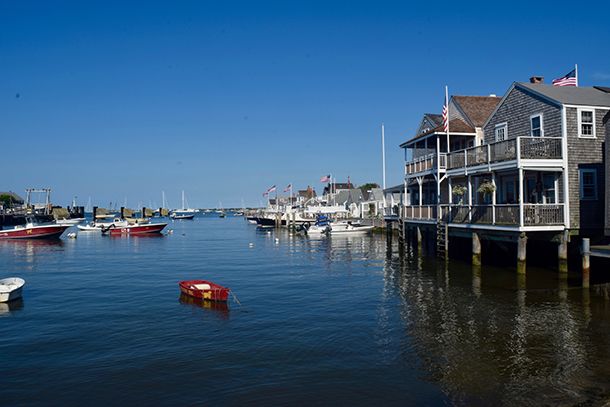
On a summer day, Nantucket Harbor is filled with boats and their lively passengers. (Photo: Savannah Christiansen)
CURWOOD: This summer, the Living on Earth team spent a week at the University of Massachusetts Boston Research Station on Nantucket Island to report on erosion and aquatic biodiversity. And while we were there, producer Noble Ingram headed to a busy wharf to record the sounds of the harbor for an audio postcard, as a folk band entertained visitors, fishmongers hacked up their catch, and a tour guide looked for customers.
[FERRY HORN, CHOPPING SOUNDS]
FISHMONGER: This is a black sea bass…
[CHOPPING SOUNDS]
Cut it by its head and then go down the spine… and then…
[CUTTING SOUND]
Down the bottom and just kind of peel the fillet off.
[CHOPPING SOUND]
COULING: You have 45,000 ships coming and going and 1,000 shipwrecks around Nantucket. And then you have over 800 pre-civil war buildings on the harbor. I’d say its haunted.
[FOLK BAND SINGING]
My name is Orion Couling. I’m a docent and a storyteller. This is a brand-new thing we are doing in Nantucket. This is the first time Egan Maritime Institute has been offering guided tours and to help it create a presence we decided we’d costume it. So, I was like, “I will totally wear costumes and tell history of Nantucket.” So earlier today I was down here in my privateer costume, which is like three layers of wool but its all part of my weight-loss training program for the summer, right? It’s not stop maritime fun for me.
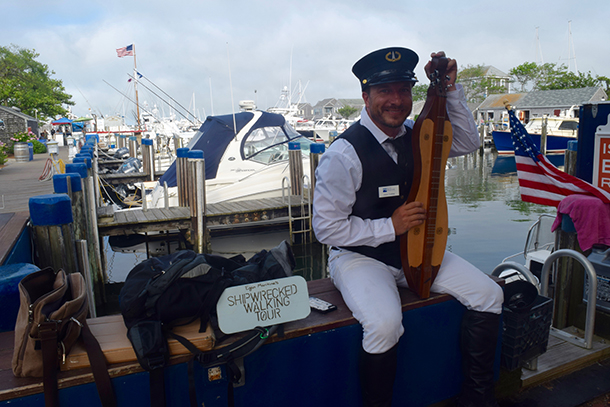
Orion Couling is a docent and storyteller for the Egan Maritime Institute on Nantucket. (Photo: Savannah Christiansen)
Right now I’m wearing this summer keeper uniform. The keepers were the captains of the station and their job was to hand-select a crew and put them through incredibly rigorous training to become decent lifesavers. So the uniform I’m wearing, I’m wearing my white britches. I’ve got my spats and boots on. I’m wearing a blue vest, and my keeper hat, which looks a little bit like a train conductor hat. These are things we forget in America. The train uniform actually directly comes from maritime uniform. Our police uniforms come from maritime uniforms. Weird things like the billy club, the police still use to this day, goes back to a belaying pin on a ship, where you make a line off to. That’s what the billy club was. Any other questions?
CHRISTIANSEN: What is this?
COULING: This is an Appalachian mountain dulcimer. Do you guys want to hear something?
[VOICES IN THE BACKGROUND RESPOND.]
Yeah, sweet. This is what’s called a fast-hall shanty. Shanties are meant to time-out efforts on boats, right? So, everyone is working together. This is meant for heaving lines and putting up the mainsail, so it has a heartbeat to it. It goes,
[SINGING] “In south Australia I was born, heave away, haul away, South Austaria round Cape Horn. We’re bound for south Australia. Haul away, you roving kings! Heave away! Haul away! All the way you hear me sing. We’re bound for south Australia.
I walked out one morning fair. Heave away! Haul away!...”
CURWOOD: Orion Couling is a docent, storyteller, and singer for the Egan Maritime Institute. That audio postcard of Nantucket wharf was produced by Living on Earth's Noble Ingram.
Related links:
- Egan Maritime Institute
- Orion Cooling with Egan Maritime
[MUSIC: MUSIC: Paul Glasse, et al, “Paper Bag Rag” on The Road To Home, composed by Benny Goodman, dos Records]
CURWOOD: Living on Earth is produced by the World Media Foundation. Our crew includes Naomi Arenberg, Bobby Bascomb, Savannah Christiansen, Jenni Doering, Noble Ingram, Jaime Kaiser, Don Lyman, Helen Palmer, Olivia Reardon, Adelaide Chen, and Jolanda Omari. Tom Tiger engineered our show, with help from Jeff Wade and Jake Rego. Alison Lirish Dean composed our themes. You can find us anytime at LOE.org - and like us, please, on our Facebook page - it’s PRI’s Living on Earth. And we tweet from @LivingonEarth. I'm Steve Curwood. Thanks for listening.
ANNOUNCER1: Funding for Living on Earth comes you, our listeners, and from the University of Massachusetts, Boston, in association with its School for the Environment, developing the next generation of environmental leaders. And from the Grantham Foundation for the protection of the environment, supporting strategic communications and collaboration in solving the world’s most pressing environmental problems. Support also comes from the Energy Foundation, serving the public interest by helping to build a strong, clean, energy economy, from Gilman Ordway, and from SolarCity, America’s solar power provider. SolarCity is dedicated to revolutionizing the way energy is delivered by giving customers a renewable alternative to fossil fuels. Information at 888-997-1703. That’s 888-997-1703.
ANNOUNCER2: PRI. Public Radio International.
Living on Earth wants to hear from you!
Living on Earth
62 Calef Highway, Suite 212
Lee, NH 03861
Telephone: 617-287-4121
E-mail: comments@loe.org
Newsletter [Click here]
Donate to Living on Earth!
Living on Earth is an independent media program and relies entirely on contributions from listeners and institutions supporting public service. Please donate now to preserve an independent environmental voice.
NewsletterLiving on Earth offers a weekly delivery of the show's rundown to your mailbox. Sign up for our newsletter today!
 Sailors For The Sea: Be the change you want to sea.
Sailors For The Sea: Be the change you want to sea.
 The Grantham Foundation for the Protection of the Environment: Committed to protecting and improving the health of the global environment.
The Grantham Foundation for the Protection of the Environment: Committed to protecting and improving the health of the global environment.
 Contribute to Living on Earth and receive, as our gift to you, an archival print of one of Mark Seth Lender's extraordinary wildlife photographs. Follow the link to see Mark's current collection of photographs.
Contribute to Living on Earth and receive, as our gift to you, an archival print of one of Mark Seth Lender's extraordinary wildlife photographs. Follow the link to see Mark's current collection of photographs.
 Buy a signed copy of Mark Seth Lender's book Smeagull the Seagull & support Living on Earth
Buy a signed copy of Mark Seth Lender's book Smeagull the Seagull & support Living on Earth

